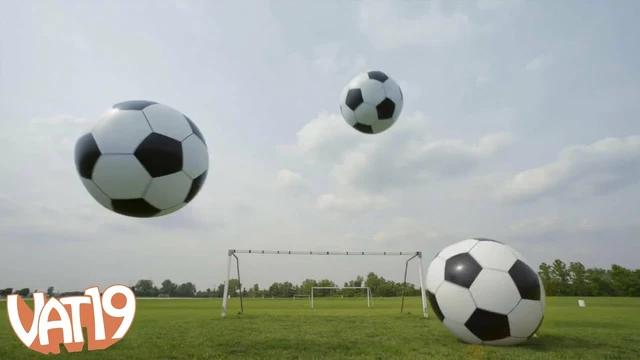
Exploring the Physics of Soccer: Examining the Impact of Helium vs. Air-Filled Balls
Have you ever wondered what would happen if you filled a soccer ball with helium instead of air? After all, the buoyancy of helium makes it lighter than air. Does this mean a helium-filled ball will fly farther than an air-filled ball?
Surprisingly, the answer is no. In fact, using helium instead of air can actually decrease the distance a soccer ball travels. This is due to a combination of factors, including air resistance and the ball’s weight. Let’s explore how these factors come into play and why a helium-filled ball doesn’t go farther than an air-filled one.
Air Resistance: The Biggest Factor
The most significant factor in determining how far a soccer ball will travel is air resistance. As the ball moves through the air, it creates a drag force that slows it down. Since helium is lighter than air, there is less drag on a helium-filled ball than on an air-filled one.
However, the difference in drag is not enough to make up for the ball's decreased weight. A helium-filled ball is lighter than an air-filled one, so it will travel slower and not go as far. So, no matter how much helium you put in the ball, it will never go farther than an air-filled ball.
The Impact of Weight
Weight is another factor that affects how far a soccer ball will travel. A heavier ball will travel farther than a lighter one because it has more momentum. Helium-filled balls are lighter than air-filled ones, so they don’t have as much momentum and won’t travel as far.
The weight of the ball also affects how much air resistance it experiences. Since helium-filled balls are lighter than air-filled ones, they experience less air resistance and slow down more quickly. This further decreases the distance they travel.
The Bottom Line
In conclusion, a helium-filled soccer ball will not travel farther than an air-filled one. This is due to a combination of factors, including air resistance and the ball’s weight. So, no matter how much helium you put in the ball, it won’t travel any farther than an air-filled one.
Does the Physics of Soccer Change When You Fill a Ball with Helium?
The physics of soccer are built around the properties of air, so it stands to reason that if you fill a soccer ball with helium, the nature of the game will change. Helium is a much lighter gas than air, so it stands to reason that a helium-filled soccer ball will move in a different way.
The first and most obvious difference is the buoyancy of a helium-filled soccer ball. A helium-filled soccer ball will be significantly lighter than one filled with air, making it easier to kick and head the ball. The lighter ball will also have a slower descent rate, allowing it to stay in the air longer and travel further than a regular soccer ball.
A helium-filled soccer ball will also be more aerodynamic, allowing it to move through the air with less drag. This means that a helium-filled soccer ball will travel at a higher speed than an air-filled one. The increased speed will also make it easier to score long-range goals, as the ball will have more time to reach its destination.
The reduced drag of a helium-filled soccer ball will also make it more difficult to predict its trajectory, making it harder for goalkeepers and defenders to anticipate where it will land. This could make scoring easier, as the ball is more likely to find its way into the goal.
Finally, a helium-filled soccer ball will be more resistant to wind than an air-filled one. This means that the ball won't be blown off course as easily, making it easier to play in windy conditions.
The physics of soccer can definitely be changed if a soccer ball is filled with helium. The lighter weight, increased speed, and increased aerodynamics of a helium-filled soccer ball will make it easier to kick and head the ball, and it will also be more resistant to wind. In conclusion, a helium-filled soccer ball will go farther than an air-filled one.
Investigating the Pros and Cons of Helium-Filled Soccer Balls: A Comparative Study
In the world of sports, athletes are always looking to gain an edge on their opponents. One such example is the debate over whether it's better to fill a soccer ball with helium or air. On one hand, helium is lighter than air and can give a soccer ball a longer flight trajectory when kicked. On the other hand, helium-filled balls can become dangerously unpredictable if they are not filled correctly. By investigating the pros and cons of helium-filled soccer balls, we can make an informed decision about the best option for maximizing performance.
Pros of Helium-Filled Soccer Balls
The primary advantage of helium-filled soccer balls is that they provide a longer flight trajectory. Helium is lighter than air, so a helium-filled ball will travel farther when kicked. This makes it easier for players to launch accurate and powerful shots from further away. Additionally, helium-filled balls tend to have a truer bounce than air-filled balls, which can be beneficial for passes and dribbling.
Cons of Helium-Filled Soccer Balls
The main drawback of helium-filled soccer balls is that they can be unpredictable if they are not filled correctly. Helium-filled balls are prone to drifting in the wind, and they can move in unexpected ways when kicked. Additionally, helium is more expensive than air, so helium-filled balls can be more costly to maintain. Finally, helium-filled balls are more likely to burst than air-filled balls, so they must be handled with care.
Conclusion
In conclusion, the pros and cons of helium-filled soccer balls must be carefully considered before making a decision. Helium-filled balls can provide a longer flight trajectory and a truer bounce, but they can also be more expensive and prone to drifting. Ultimately, it is up to the player to decide which option is best for their specific needs and circumstances.


